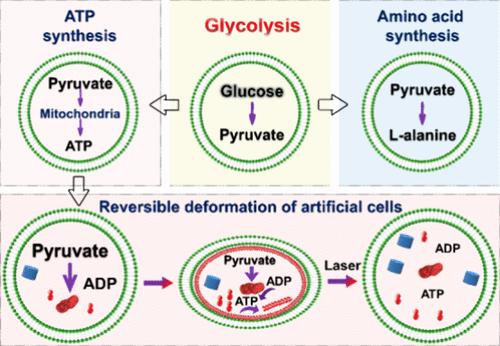当前位置:
X-MOL 学术
›
J. Am. Chem. Soc.
›
论文详情
Our official English website, www.x-mol.net, welcomes your feedback! (Note: you will need to create a separate account there.)
Construction of the Glycolysis Metabolic Pathway Inside an Artificial Cell for the Synthesis of Amino Acid and Its Reversible Deformation
Journal of the American Chemical Society ( IF 14.4 ) Pub Date : 2024-07-23 , DOI: 10.1021/jacs.4c06227 Boyu Yang 1 , Chao Li 1 , Yongshuo Ren 1 , Weichen Wang 1 , Xiangxiang Zhang 1 , Xiaojun Han 1
Journal of the American Chemical Society ( IF 14.4 ) Pub Date : 2024-07-23 , DOI: 10.1021/jacs.4c06227 Boyu Yang 1 , Chao Li 1 , Yongshuo Ren 1 , Weichen Wang 1 , Xiangxiang Zhang 1 , Xiaojun Han 1
Affiliation

|
The bottom-up construction of artificial cells is beneficial for understanding cell working mechanisms. The glycolysis metabolism mimicry inside artificial cells is challenging. Herein, the glycolytic pathway (Entner–Doudoroff pathway in archaea) is reconstituted inside artificial cells. The glycolytic pathway comprising glucose dehydrogenase (GDH), gluconate dehydratase (GAD), and 2-keto-3-deoxygluconate aldolase (KDGA) converts glucose molecules to pyruvate molecules. Inside artificial cells, pyruvate molecules are further converted into alanine with the help of alanine dehydrogenase (AlaDH) to build a metabolic pathway for synthesizing amino acid. On the other hand, the pyruvate molecules from glycolysis stimulate the living mitochondria to produce ATP inside artificial cells, which further trigger actin monomers to polymerize to form actin filaments. With the addition of methylcellulose inside the artificial cell, the actin filaments form adjacent to the inner lipid bilayer, deforming the artificial cell from a spherical shape to a spindle shape. The spindle-shaped artificial cell reverses to a spherical shape by depolymerizing the actin filament upon laser irradiation. The glycolytic pathway and its further extension to produce amino acids (or ATP) inside artificial cells pave the path to build functional artificial cells with more complicated metabolic pathways.
中文翻译:

人工细胞内氨基酸合成及其可逆变形糖酵解代谢途径的构建
人工细胞自下而上的构建有利于理解细胞的工作机制。人造细胞内的糖酵解代谢模拟具有挑战性。在此,糖酵解途径(古细菌中的 Entner-Doudoroff 途径)在人造细胞内重建。糖酵解途径包括葡萄糖脱氢酶 (GDH)、葡萄糖酸脱水酶 (GAD) 和 2-酮-3-脱氧葡萄糖酸醛缩酶 (KDGA),将葡萄糖分子转化为丙酮酸分子。在人造细胞内,丙酮酸分子在丙氨酸脱氢酶(AlaDH)的帮助下进一步转化为丙氨酸,建立合成氨基酸的代谢途径。另一方面,糖酵解产生的丙酮酸分子刺激活线粒体在人造细胞内产生 ATP,进一步触发肌动蛋白单体聚合形成肌动蛋白丝。随着人造细胞内添加甲基纤维素,肌动蛋白丝在内部脂质双层附近形成,使人造细胞从球形变形为纺锤形。通过激光照射使肌动蛋白丝解聚,纺锤形人造细胞反转为球形。糖酵解途径及其在人造细胞内产生氨基酸(或ATP)的进一步延伸,为构建具有更复杂代谢途径的功能性人造细胞铺平了道路。
更新日期:2024-07-25
中文翻译:

人工细胞内氨基酸合成及其可逆变形糖酵解代谢途径的构建
人工细胞自下而上的构建有利于理解细胞的工作机制。人造细胞内的糖酵解代谢模拟具有挑战性。在此,糖酵解途径(古细菌中的 Entner-Doudoroff 途径)在人造细胞内重建。糖酵解途径包括葡萄糖脱氢酶 (GDH)、葡萄糖酸脱水酶 (GAD) 和 2-酮-3-脱氧葡萄糖酸醛缩酶 (KDGA),将葡萄糖分子转化为丙酮酸分子。在人造细胞内,丙酮酸分子在丙氨酸脱氢酶(AlaDH)的帮助下进一步转化为丙氨酸,建立合成氨基酸的代谢途径。另一方面,糖酵解产生的丙酮酸分子刺激活线粒体在人造细胞内产生 ATP,进一步触发肌动蛋白单体聚合形成肌动蛋白丝。随着人造细胞内添加甲基纤维素,肌动蛋白丝在内部脂质双层附近形成,使人造细胞从球形变形为纺锤形。通过激光照射使肌动蛋白丝解聚,纺锤形人造细胞反转为球形。糖酵解途径及其在人造细胞内产生氨基酸(或ATP)的进一步延伸,为构建具有更复杂代谢途径的功能性人造细胞铺平了道路。












































 京公网安备 11010802027423号
京公网安备 11010802027423号